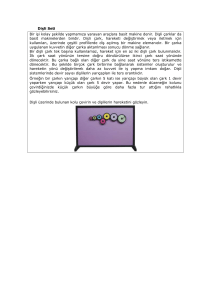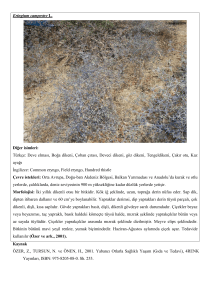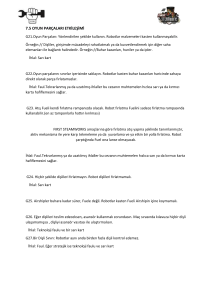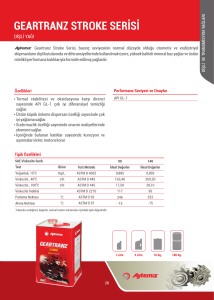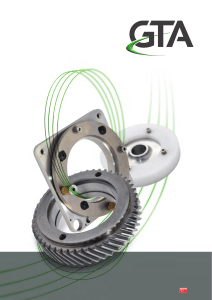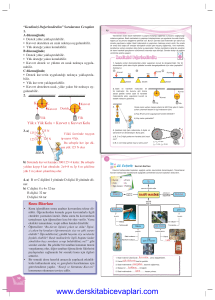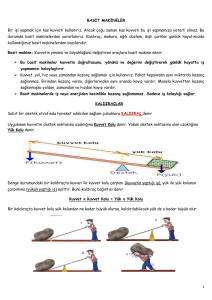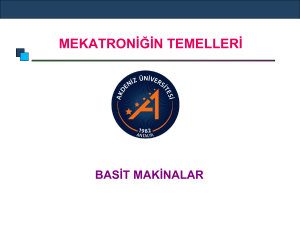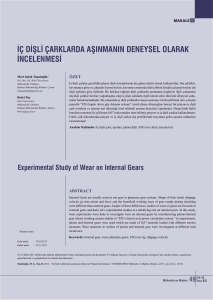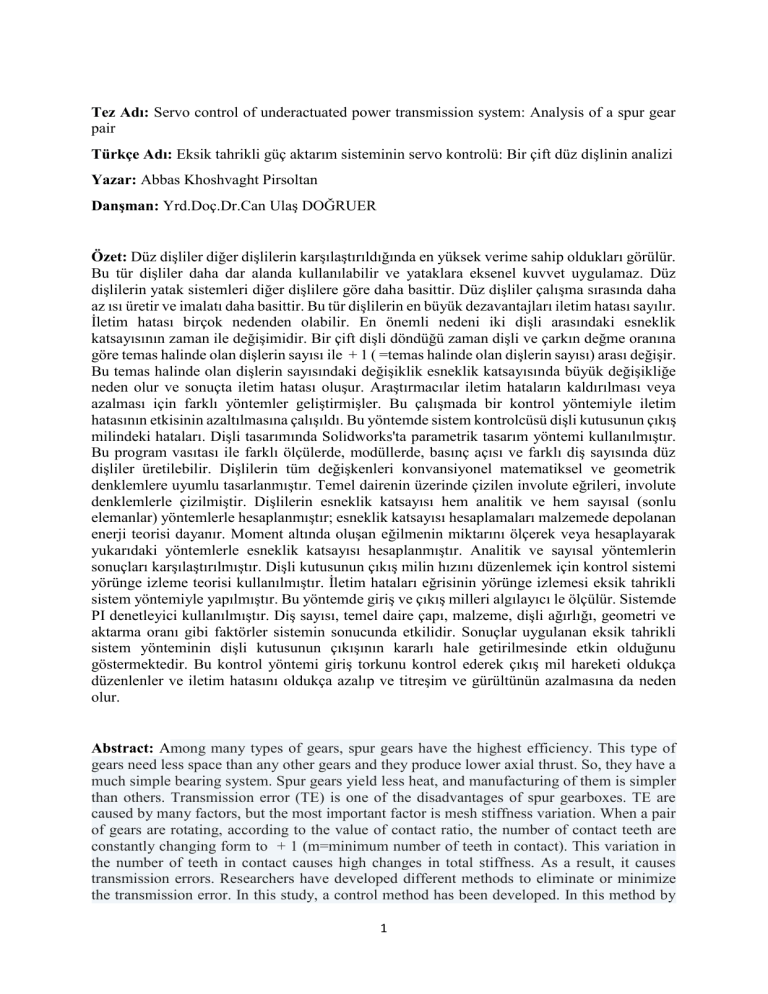
Tez Adı: Servo control of underactuated power transmission system: Analysis of a spur gear
pair
Türkçe Adı: Eksik tahrikli güç aktarım sisteminin servo kontrolü: Bir çift düz dişlinin analizi
Yazar: Abbas Khoshvaght Pirsoltan
Danşman: Yrd.Doç.Dr.Can Ulaş DOĞRUER
Özet: Düz dişliler diğer dişlilerin karşılaştırıldığında en yüksek verime sahip oldukları görülür.
Bu tür dişliler daha dar alanda kullanılabilir ve yataklara eksenel kuvvet uygulamaz. Düz
dişlilerin yatak sistemleri diğer dişlilere göre daha basittir. Düz dişliler çalışma sırasında daha
az ısı üretir ve imalatı daha basittir. Bu tür dişlilerin en büyük dezavantajları iletim hatası sayılır.
İletim hatası birçok nedenden olabilir. En önemli nedeni iki dişli arasındaki esneklik
katsayısının zaman ile değişimidir. Bir çift dişli döndüğü zaman dişli ve çarkın değme oranına
göre temas halinde olan dişlerin sayısı ile + 1 ( =temas halinde olan dişlerin sayısı) arası değişir.
Bu temas halinde olan dişlerin sayısındaki değişiklik esneklik katsayısında büyük değişikliğe
neden olur ve sonuçta iletim hatası oluşur. Araştırmacılar iletim hataların kaldırılması veya
azalması için farklı yöntemler geliştirmişler. Bu çalışmada bir kontrol yöntemiyle iletim
hatasının etkisinin azaltılmasına çalışıldı. Bu yöntemde sistem kontrolcüsü dişli kutusunun çıkış
milindeki hataları. Dişli tasarımında Solidworks'ta parametrik tasarım yöntemi kullanılmıştır.
Bu program vasıtası ile farklı ölçülerde, modüllerde, basınç açısı ve farklı diş sayısında düz
dişliler üretilebilir. Dişlilerin tüm değişkenleri konvansiyonel matematiksel ve geometrik
denklemlere uyumlu tasarlanmıştır. Temel dairenin üzerinde çizilen involute eğrileri, involute
denklemlerle çizilmiştir. Dişlilerin esneklik katsayısı hem analitik ve hem sayısal (sonlu
elemanlar) yöntemlerle hesaplanmıştır; esneklik katsayısı hesaplamaları malzemede depolanan
enerji teorisi dayanır. Moment altında oluşan eğilmenin miktarını ölçerek veya hesaplayarak
yukarıdaki yöntemlerle esneklik katsayısı hesaplanmıştır. Analitik ve sayısal yöntemlerin
sonuçları karşılaştırılmıştır. Dişli kutusunun çıkış milin hızını düzenlemek için kontrol sistemi
yörünge izleme teorisi kullanılmıştır. İletim hataları eğrisinin yörünge izlemesi eksik tahrikli
sistem yöntemiyle yapılmıştır. Bu yöntemde giriş ve çıkış milleri algılayıcı le ölçülür. Sistemde
PI denetleyici kullanılmıştır. Diş sayısı, temel daire çapı, malzeme, dişli ağırlığı, geometri ve
aktarma oranı gibi faktörler sistemin sonucunda etkilidir. Sonuçlar uygulanan eksik tahrikli
sistem yönteminin dişli kutusunun çıkışının kararlı hale getirilmesinde etkin olduğunu
göstermektedir. Bu kontrol yöntemi giriş torkunu kontrol ederek çıkış mil hareketi oldukça
düzenlenler ve iletim hatasını oldukça azalıp ve titreşim ve gürültünün azalmasına da neden
olur.
Abstract: Among many types of gears, spur gears have the highest efficiency. This type of
gears need less space than any other gears and they produce lower axial thrust. So, they have a
much simple bearing system. Spur gears yield less heat, and manufacturing of them is simpler
than others. Transmission error (TE) is one of the disadvantages of spur gearboxes. TE are
caused by many factors, but the most important factor is mesh stiffness variation. When a pair
of gears are rotating, according to the value of contact ratio, the number of contact teeth are
constantly changing form to + 1 (m=minimum number of teeth in contact). This variation in
the number of teeth in contact causes high changes in total stiffness. As a result, it causes
transmission errors. Researchers have developed different methods to eliminate or minimize
the transmission error. In this study, a control method has been developed. In this method by
1
using a control law, system can regulate output of gearbox. Here, gear parametric design
method is done in Solidworks program. It is possible to generate different spur gears with
different teeth numbers, module, tooth wide, and pressures angle. All parameters of gears are
in accordance with conventional mathematical and geometric equations of gear design. Involute
curves on the base circle are designed according to Involute equation. Also, typical spur gearbox
is designed to have gear pair with real parameters. Gears mesh stiffness is computed by using
both analytical and numerical (Finite Element) methods. Mesh stiffness computation is based
on the theory of energy stored in the material. Deflection value is obtained based on the applied
moment, and stiffness is calculated by using that method. The results of the analytical and finite
element methods are compared with each other. Control system design for regulation and
linearization of gearbox output are done according to the theory of trajectory tracking.
Trajectory tracking of transmission error curve is done by the method of underactuated
multibody system. In this method, output is measured by sensors. The system is linearized and
the remaining linear portion of the dynamics is controlled with a PI controller. Factors such as
the number of teeth, gear base circle diameter, material, weight, geometry, and transmission
ratio are effective in system responses. The results show that the method of underactuated
multibody system is effective in regulation gearbox output. When this control law is used to
control the torque input acting on the designed gearbox, the output will be quite uniform,
transmission error will be minimized, and vibration and noise will be decreased.
2

